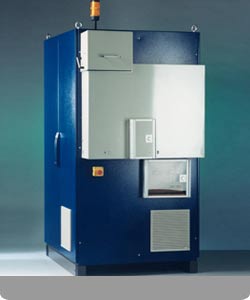Description
The analysis of the slag accumulating during the production of steel plays an important role in process control. For this reason, the availability of a precise, timesaving multi-element analysis is of vital importance. Currently, a time-intensive preparation of the samples is necessary, in order to be able to analyse the slag samples using X-ray fluorescence spectroscopy. SALIS is based on laser emission spectrometry, in particular LIBS – Laser-Induced Breakdown Spectroscopy. In this procedure, a pulsed laser beam is focused on the sample, a small amount of the material is ablated and plasma is generated. The plasma radiation is detected time-resolved with a Paschen-Runge arranged spectrometer. A preparation of the sample can thus be dispensed with. SALIS is designed for the quantitative analysis of the following materials: CaO, SiO2, Fetot, Mn, MgO, Al2O3, TiO2, P2O5 and S. Due to new developments in the areas of mechanics, electronics, laser pulse modulation and multi-element calibration technology, the analysis results conform to metallurgical standards. As an average value, a relatively standard deviation of 2.5% is achieved for all detected elements. By reducing the duration of the analysis by a factor of 2, the results of the analysis for process control are available faster.

| Technical Specifications | |
|---|---|
| Duration of Analysis: | 1 to 2 minutes per sample |
| Elements Analysed: | Ca, Si, Fe, Mn, Mg, Al, Ti, P, S |
| Material Analysed: | Vitreous, solid slag, compacted briquette, moulding, pellets |
| Types of Slag: | Cement slag, ladle or pan slag, vacuum slag |
| Laser | Flash-lamp pumped Nd:YAG Laser, programmable pulse modulation and pulse energy |
| Optical Detection System: | Paschen-Runge arranged spectrometer, multi-channel, integrator electronics MCI, time-resolved signal detection |
| Software | Sirius-M, MS-Windows® |
